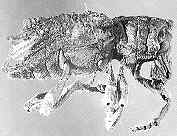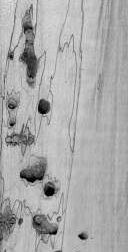Almost all weevils are associated with woody plants and all parts are fed upon: wood, cambium, roots, leaves, seeds, fruits, flowers and terminal shoots. Therefore weevils are severe pests of agricultural and forestry crops as well as stored products. There is hardly any plant that cannot be infested by at least one weevil species.
Common wood-boring weevil pests are for instance Vanapa oberthuri, Illacuris laticollis, Aesiotes notabilis and Sympiezoscelus. These weevils usually take advantage of the host’s decreased natural resistance caused by injury, diseases, fire and other stress factors. Illacuris laticollis can be frequently encountered on stressed or dying trees after forest fires, where the females lay eggs on the margin of resin flow. The pine bark weevil Aesiotes notabilis is mainly associated with standing Araucaria spp., Agathis spp. and Pinus spp. In plantations an infestation usually occurs on injuries caused by pruning. The larvae feed on the phloem next to the pruning wound. Pupation takes place in the wood. The typical bore holes of weevils are filled with putty-like frass that shrinks when dried. Thus these holes can be easily distinguished from pin- and shot-holes that are always free of dust. An Aesiotes attack can introduce fungal diseases into the tree or can be followed by a secondary infestation. Other destructive wood-boring weevils of Hoop and Klinkii are Mitrastethus australiae, Orthorhinus patruelis and Coptocorynus.
Oribius destructor and O. inimicus are some of the few weevils that feed on leaves. The adults of both species are common pests of various agricultural crops and of Eucalyptus spp.
Weevils in general are difficult to control due to their cryptic way of life, their tough and heavily sclerotized cuticle and the long life span of the adults. However, there is also a number of good bugs that are in use as biocontrol agents, like the introduced Cyrtobagous salviniae, that is used to control the noxious water fern Salvinia molesta on the middle and lower Sepik. Two other weevil species, Neochetina eichhorniae and N. bruchi are currently being tested to control another noxious weed, the water hyacinth on the River Sepik.
Some of the subfamilies and genera occurring in PNG are the Zygopinae (Arachnopus and Mecopus), Lixinae (Lixus), Otiorhynchinae (Oribius, Apocyrtus, Trigonopus, Hellerhinus), Erirhininae (Cyrtobagous salviniae), Brachyderinae (Pantorhytes, Sphenomorpha and Cataphracta), Leptopiinae (the very handsome and metallic blue, green or reddish Painted Weevils like Gymnopholus and Eupholus), Rhyncophorinae (Trigonotarsus rugosus, the sago and palm beetles Rhyncophorus), Baridinae (Pseudochlus), Hylobiinae (Vanapa, etc.).

Aesiotes notabilis
(reproduced from Peters, B.C.
et al., 1996)
Oribius destructor
(reproduced from Thistleton,
B.M., 1984)
